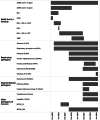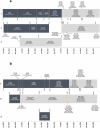Human pathogen nucleic acids in wastewater solids from 191 wastewater treatment plants in the United States
- PMID: 39420189
- PMCID: PMC11487133
- DOI: 10.1038/s41597-024-03969-8
Human pathogen nucleic acids in wastewater solids from 191 wastewater treatment plants in the United States
Erratum in
-
Author Correction: Human pathogen nucleic acids in wastewater solids from 191 wastewater treatment plants in the United States.Sci Data. 2024 Dec 20;11(1):1410. doi: 10.1038/s41597-024-04257-1. Sci Data. 2024. PMID: 39706826 Free PMC article. No abstract available.
Abstract
We measured concentrations of severe acute respiratory syndrome coronavirus 2 (SARS-CoV-2) and its variants, influenza A and B viruses, respiratory syncytial virus, human metapneumovirus, enterovirus D68, human parainfluenza types 1, 2, 3, 4a, and 4b in aggregate, norovirus genotype II, rotavirus, Candida auris, hepatitis A virus, human adenovirus, mpox virus, H5 influenza A virus, and pepper mild mottle virus nucleic acids in wastewater solids prospectively at 191 wastewater treatment plants in 40 states across the United States plus Washington DC. Measurements were made two to seven times per week from 1 January 2022 to 30 June 2024, depending on wastewater treatment plant staff availability. Measurements were made using droplet digital (reverse-transcription-) polymerase chain reaction (ddRT-PCR) following best practices for making environmental molecular biology measurements. These data can be used to better understand disease occurrence in communities contributing to the wastewater.
© 2024. The Author(s).
Conflict of interest statement
Bradley White, Dorothea Duong, Bridgette Shelden, and Vikram Chan-Herur are employees of Verily Life Sciences. The other authors have no competing interests.
Figures






References
-
- Bivins, A. et al. Wastewater-Based Epidemiology: Global Collaborative to Maximize Contributions in the Fight Against COVID-19. Environ. Sci. Technol.54, 7754–7757 (2020). - PubMed
-
- Boehm, A. B. et al. Human norovirus (HuNoV) GII RNA in wastewater solids at 145 United States wastewater treatment plants: Comparison to positivity rates of clinical specimens and modeled estimates of HuNoV GII shedders. Journal of Exposure Science & Environmental Epidemiology10.1038/s41370-023-00592-4 (2023). - PMC - PubMed
Publication types
MeSH terms
Substances
LinkOut - more resources
Full Text Sources
Miscellaneous

